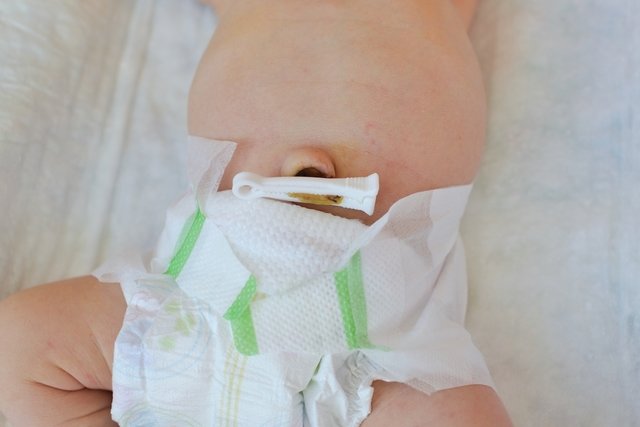The umbilical cord in newborns is a small part of the umbilical cord from inside the wound that remains attached to the baby's navel after birth. It will dry naturally until it falls off, which normally happens around the 3rd week of life.
It is common in the first few days after birth, for the umbilical cord to appear gelatinous, moist and shiny, and to have a white or yellow color. It will then become dry, hardened and black over time.
The umbilical cord requires care and monitoring until it falls off, as while it remains attached, there is a risk for infections and inflammation. It is important to consult a pediatrician if the newborn's umbilical cord develops yellow discharge or if the skin around it becomes red.

Care considerations
Some care measures that should be performed while the newborn has an attached umbilical cord include:
- Avoid touching or holding the umbilical stump, except when cleaning it
- Allow the umbilical stump to fall naturally
- Always keep the umbilical stump clean and dry
- Wash your hands with soap and water before handling the umbilical stump
- Do not use homemade products, bands, belts, coins or clothing that may squeeze baby's navel, as this increases the risk for infection
- Do not cover the umbilical stump with the diaper, leaving it folded about two fingers below the navel, so that the area does not become tight or soiled with urine and/or feces.
These precautions are important so that the baby's belly button heals more quickly and does not become infected. These should be maintained until the umbilical cord falls off naturally.
Signs of infection
Some signs that the umbilical cord is infected include a foul smell, yellow discharge, and redness and/or swelling in the surrounding skin. These symptoms should be assessed by a pediatrician if they appear, to rule out the possibility of infection.
A belly button infection can be serious in some cases and treatment is usually carried out in the hospital with IV antibiotics.
How to clean an umbilical cord
To clean the umbilical stump, you you should
- Expose the umbilical cordmp, removing any clothing that is covering the area.
- Wash your hands well with soap and water.
- Moisten some sterile gauze with 70% alcohol or 0.5% alcoholic chlorhexidine.
- Hold the clamp at the end of the umbilical cord with the index finger and thumb of the hand opposite to the one that will be cleaning to elevate the stump, but without pulling it.
- Use one of the moistened gauze pads to clean the area where the umbilical cord inserts into the skin, using a single circular motion, then throw this pad away;
- Use another moistened gauze to clean the body of the umbilical stump, from the bottom of the cord nearest the skin up toward the clamp in one single movement. Then discard the gauze;
- Clean the clamp with a new moistened gauze, starting at one end and going all the way around, so that the clamp is completely clean;
- Leave to air dry until the alcohol or alcoholic chlorhexidine evaporates completely.
Cleaning the umbilical stump should not cause pain, but it is normal for the baby to cry, as the cleansing agents may be cold.
When does the umbilical cord fall off?
The umbilical stump normally falls between 7 and 21 days of life. Be sure to consult a pediatrician if it has not yet fallen after this time.
What to do after the cord falls off
After the umbilical cord falls off, it is important to continue monitoring and cleaning the belly button until it has completely healed. After bathing, it is important to dry the belly button with a compress or clean cloth, using gentle circular movements.
Do not place a coin or other object to prevent the navel from sticking out, as this can cause serious infection in the baby, mainly because the bacteria contained in these objects can spread into the body through the newborn's belly button..
When to go to the pediatrician
The newborn should be assessed by a pediatrician if he or she presents with any of the following symptoms:
- Bleeding from the umbilical cord
- Foul odor
- Yellow discharge or pus
- Fever
- Redness and/or swelling at the site
- Crying when touched in the naval area
Furthermore, it is also important to consult your pediatrician if your baby's belly button takes more than 21 days to fall off.
